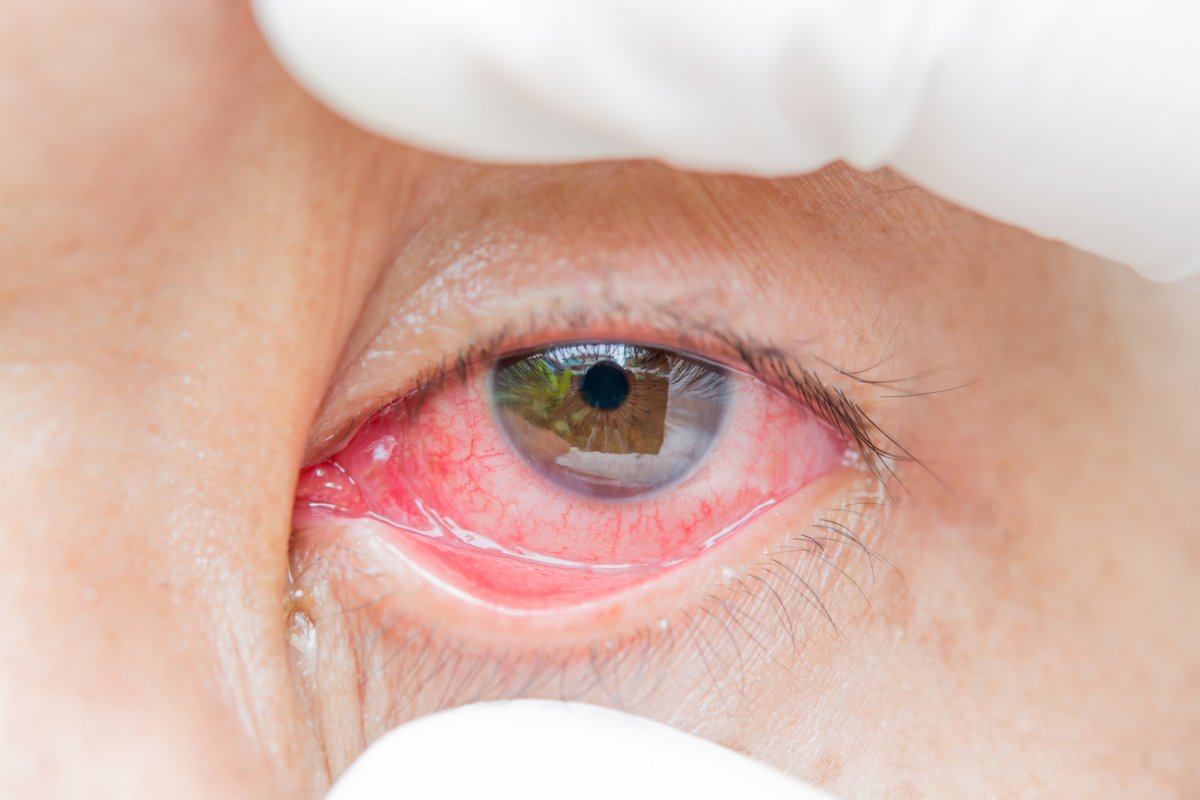An outbreak of viral conjunctivitis has infected nearly 400,000 people across Pakistan since the start of the year.
The pink-eye outbreak hit its peak last week, with over 10,000 cases being reported in a 24-hour period on Saturday across Punjab. This was according to the province's Primary and Secondary Health Department. Some 13,000 new cases were reported in a single day on Tuesday.
Conjunctivitis is an inflammation of the mucous membrane covering the front of the eye and eyelids, known as the conjunctiva. Infection of this membrane can lead to conjunctivitis, and is often caused by bacteria, or in the cases throughout Pakistan, viruses.
"Many different types of viruses can cause viral conjunctivitis (including the COVID-19 virus). However, the majority, up to 75 percent, of infectious conjunctivitis are caused by adenovirus," Isabelle Jalbert, professor of optometry and vision science at UNSW Sydney, Australia, told Newsweek. "It appears that the outbreak in Pakistan involves a highly contagious form of the virus."

"The best cure for adenovirus conjunctivitis is to prevent the infection and to limit its spread," Jalbert said. "Public-health infection control measures are what is needed. Thus, the closure of schools is a sensible public-health measure to attempt to break the epidemic.
"It is difficult to get children to avoid touching each other, and they are unlikely to wash their hands as much as would be needed. One infected child can easily spread this condition to others at school," Jalbert added.
This epidemic led to over 56,000 schools across the province of Punjab being closed between September 28 and October 1 in an effort to slow infections.
"The closure has been announced as a proactive measure to give maximum protection to students against the infection," Punjab education department spokesman Zulfiqar Ali told Agence France-Presse. "We hope this will break the cycle of the infection in the province."
The school closures may have contributed to a sudden dip in infections: only 1,134 cases were reported in the 24-hour period between Sunday and Monday.
Adenovirus conjunctivitis is often spread by direct contact (eye-hand contact), but can also be spread via coughing and sneezing. Symptoms include inflamed pink eyes, eyelid swelling and itching, and the production of tears and pus from the eyes.
"Infected people that have very red and teary, watery eyes will wipe their eyes and then spread the virus by touching others. Adenovirus also spreads in communities by what is called 'fomites' through inanimate objects: it is known to have the ability to resist desiccation or drying out and can remain alive for long periods (days) on surfaces such as door handles, counter surfaces, etc." Jalbert said.
"[Conjunctivitis] can also be caused by bacteria (e.g., Staphylococcus aureus, Haemophilus influenzae and others like chlamydia and gonorrhea) and by other viruses including, sometimes, the herpes viruses that causes cold sores and that associated with chickenpox and shingles. But, of these, adenovirus is by far the most contagious," Jalbert added.

Viral conjunctivitis is usually mild, going away naturally after 1 to 2 weeks, with patients being advised to stay at home to prevent the spread of the condition.
"Eye doctors and general practitioners would typically manage this by advising patients to stay at home for at least 10 days following the start of symptoms to limit the spread, a bit like an individual mini-lockdown," Jalbert said.
"It is important that patients, teachers, and health practitioners manage the contagion risk by using PPE (e.g., disposable gloves); using disposable tissues and discarding them properly; washing hands carefully before and after touching the eyes; avoid sharing towels, pillowcases, and other personal items; and disinfecting surfaces with germicide sprays."
Antibiotics will be useless against viral conjunctivitis as they kill only bacterial infections. However, antiviral medicines may be prescribed if a viral conjunctivitis case becomes more severe. Symptoms can be helped using eye drops.
"None of the current commercially available antiviral and antibiotic eyedrops are effective for this condition," Jalbert said. "Other types of eyedrops that can be recommended are those that can help relieve symptoms including single-dose 0.9 percent saline eyedrops and single-dose lubricating eyedrops. Multidose bottles of eyedrops must be avoided, as once a bottle is contaminated, this could spread the infection to the other eye, reinfect an eye, and spread the virus to others and if an eyedrop bottle is shared.
"Research suggests that low-concentration povidone iodide (this is betadine) 0.25 percent eyedrops could help to speed up the resolution of the eye infection, but, unfortunately, preparations of these for the eye are not commercially available and would need to be made at hospital pharmacies," Jalbert added.
"For those people who develop complications such as corneal infiltrates, white spots in the cornea, and eyelid membranes where symptoms persists or their vision is affected, there are treatments such as corticosteroid eyedrops that can be prescribed by eye doctors to minimize the inflammation and manage these complications. This must then be managed by an eye doctor (e.g., optometrist or ophthalmologist)."
Do you have an animal or nature story to share with Newsweek? Do you have a question about conjunctivitis? Let us know via science@newsweek.com.
Uncommon Knowledge
Newsweek is committed to challenging conventional wisdom and finding connections in the search for common ground.
Newsweek is committed to challenging conventional wisdom and finding connections in the search for common ground.
About the writer
Jess Thomson is a Newsweek Science Reporter based in London UK. Her focus is reporting on science, technology and healthcare. ... Read more
To read how Newsweek uses AI as a newsroom tool, Click here.






